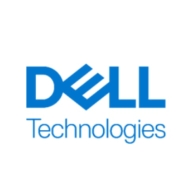

The Dell PowerEdge R-Series and HPE ProLiant DL Servers are prominent competitors in the server market, offering robust solutions for businesses of all sizes. The Dell PowerEdge R-Series appears to have an edge due to its remote management capabilities and cost-effectiveness, as highlighted in user feedback.
Features: Dell PowerEdge R-Series stands out with its ability to handle high-performance workloads effectively. It offers strong remote management through iDRAC, flexibility in storage, hyper-converged capabilities, and an energy-efficient design. HPE ProLiant DL Servers boast ease of management via HPE iLO, a modular design for flexibility, and comprehensive manageability tools that cater to varied business needs.
Room for Improvement: Dell PowerEdge R-Series could benefit from better integration of firmware updates to minimize downtime, faster delivery times for hardware, and improved analytics for server health monitoring. Users also seek more compact design options and enhanced training support. HPE ProLiant DL Servers face challenges with high pricing and licensing fees and could enhance their maintenance processes. The integration of advanced automation features is an area for potential expansion.
Ease of Deployment and Customer Service: Both Dell PowerEdge R-Series and HPE ProLiant DL Servers are effective across on-premises and hybrid cloud environments. Dell supports its products with proactive customer service, including direct engineer visits and efficient parts supply, generally receiving positive reviews. HPE ProLiant offers responsive customer service, though some users feel it lacks the quick resource allocation and turnaround times that Dell provides, giving Dell a slight superiority in this aspect.
Pricing and ROI: Dell PowerEdge R-Series is acknowledged for its relatively competitive pricing. It delivers favorable ROI due to its reliability and performance efficiency, making it accessible across a spectrum of business sizes. While considered cost-effective, Dell’s pricing can still be high but offers better scaling with business needs. In contrast, HPE ProLiant DL Servers are sometimes perceived as expensive, especially when accounting for advanced feature licensing. They do ensure good ROI with strong performance and durability, though their costs can be steeper than Dell’s, positioning Dell as a more cost-efficient choice in terms of price-to-performance ratio.
By not having to worry about it, I would estimate we save two to four hours a week, depending on what's happening, such as if we need to spin up a new server, which would contribute to more time if done the old way.
In my immediate case for antenna analysis, Dell PowerEdge Rack Servers offer a reduction from days of computing to half a day or hours.
The value of uptime to us is critical.
In terms of percentage, I am saving from 5 to 10%.
I would give Dell PowerEdge Rack Servers a ten because they're always able to answer all the questions we have; they reach a solution no matter how long it takes, and they don't give up.
It has always been scheduled maintenance, which says a lot for a production environment, as we haven't had to call in a trouble ticket for the actual hardware during its entire run.
Typically, the contacts we have on-site are very knowledgeable, they come in within a day and usually have it fixed and taken care of if there are issues.
We do not communicate directly with HPE's technical support because our local support company is primarily responsible.
The scalability of Dell PowerEdge Rack Servers is excellent.
Any outages or blackouts are limited to particular servers, not affecting the whole chassis or enclosures.
We bought our product with scaling involved, and we've been scaling it up anytime we've needed more storage.
From our usage point of view, we rely less on onboard storage, depending instead on SANs and NAS, and the fiber connections and throughput are satisfactory.
Over four years, we've had less than 1 percent downtime.
There is a feature to update the server while it is running, so there is no need to restart.
We have truly not had any downtime on the infrastructure at all.
Since the distributors are not physically present in Pakistan, that creates a risk for long-term large customers.
We need to know about any upcoming updates so that we can plan accordingly.
The beneficial aspect of that feature was that we could skip the PowerStore and just have the Dell PowerEdge Rack Servers alone, as they also served as storage, which helped us save money.
This forces you to go up to a larger server to get the desired processor, which increases the cost.
Improvements could be made in database engine hosting services because, as it stands, the pricing of Oracle is too high from both the service and software solution perspectives.
They have been stable and running for years without performance downtime or significant disc failures.
Some customers find it cheaper due to contractual agreements, while others find it expensive, especially when scaling up.
The software associated with servers, like VMware subscription licenses, drives costs.
They keep running for at least five to seven years without any issues.
With PowerEdge Servers, I don't need a one-to-one ratio redundancy, which leads to about eighty percent downtime reduction.
One of the valuable features is Active Directory, which helps in managing the network.
The price-performance ratio is better than IBM counterparts, which is why we have opted for these solutions.
| Product | Market Share (%) |
|---|---|
| Dell PowerEdge R-Series | 26.7% |
| HPE ProLiant DL Servers | 21.1% |
| Other | 52.2% |


| Company Size | Count |
|---|---|
| Small Business | 94 |
| Midsize Enterprise | 58 |
| Large Enterprise | 112 |
| Company Size | Count |
|---|---|
| Small Business | 55 |
| Midsize Enterprise | 28 |
| Large Enterprise | 98 |
PowerEdge R-Series delivers high performance, flexibility, and scalability for data centers. It supports demanding tasks with robust management tools and advanced cooling, providing reliability and efficiency across various workloads.
Engineered for large deployments, PowerEdge R-Series supports extensive configurations optimizing performance in data centers. With features like advanced cooling and energy-efficient architecture, it empowers organizations to manage heavy workloads while facilitating seamless scalability. It offers remote management, robust security, and integration with VMware ensuring operational excellence and high availability for business-critical applications.
What are the key features of Dell PowerEdge R-Series?PowerEdge R-Series is deployed across industries for virtualization, database hosting, and application servers. It supports environments like VMware and Hyper-V for AI, cloud infrastructure, and computing tasks. Widely used by finance, healthcare, and academia, it enhances reliability and efficiency of IT infrastructure.
HPE ProLiant DL Servers are known for their reliability, scalability, and robust performance. They deliver advanced management capabilities and excel in handling high workloads, offering cost efficiency and versatile customization options suited for diverse enterprise needs.
HPE ProLiant DL Servers feature a user-friendly design that facilitates quick deployment and efficient maintenance. Their advanced iLO technology supports remote management, allowing users to handle server operations efficiently. Users appreciate the system's compatibility with multiple applications and infrastructures, along with robust support services. Despite these strengths, some models have issues like missing front ports, slow boot times, and a reliance on Java for management tasks. Suggestions for improvement include enhanced power monitoring, refined software, better redundancy, and energy-efficient operation. Many look for improved virtualization capabilities and faster processors. Support and documentation inconsistencies are also noted concerns.
What are the key features of HPE ProLiant DL Servers?HPE ProLiant DL Servers are widely implemented in enterprise and educational settings, excelling in virtualization on VMware and Hyper-V platforms. They support databases like Oracle and MongoDB and are essential for high-performance computing and AI projects. These servers are integrated into system environments, supporting rack and hyperconversion setups effectively.
We monitor all Rack Servers reviews to prevent fraudulent reviews and keep review quality high. We do not post reviews by company employees or direct competitors. We validate each review for authenticity via cross-reference with LinkedIn, and personal follow-up with the reviewer when necessary.